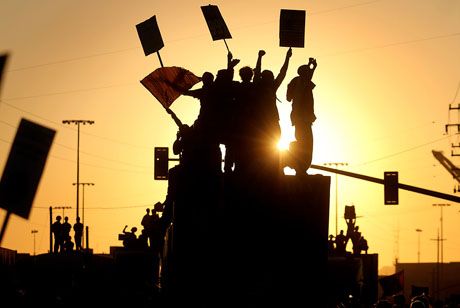Columns
You are here
Let’s rebuild the labour movement from the bottom up

July 3, 2013
Hundreds of thousands are demonstrating in Tahrir Square once more, and working people and the poor are taking to the streets in Brazil against the austerity agenda. Fifty thousand demonstrated recently in Montreal against the cuts to employment insurance showing once again the militancy that Occupy, the Quebec student strike and Idle No More put on the political agenda in this country. Representatives of the groups organizing around EI in both New Brunswick and Quebec recently spoke in Toronto to a packed hall of labour and community activists hoping to kickstart a similar campaign in Ontario.
The threat of anti-worker legislation by Tim Hudak, leader of the Progressive Conservative opposition in Ontario, has forced many unions to take up a workers’ rights agenda to inoculate their members against these attacks. The United Steelworkers, CUPE ,OPSEU and others are rolling out campaigns to connect with their members. A top-down effort will not work. Every member must be involved in the conversation about the need for a strong working class response and why unions are so necessary to fight back against the austerity agenda.
Today it is critical that an understanding of a rank-and-file strategy be part of any fightback. Labour leaders are usually long from the tools and often feel it’s easier to compromise and make a deal than to lead a militant fightback against concessions. They are a layer that exists between the workers and management. They make salaries that put them in a category above those they represent and often spend more time in negotiations and meetings with the boss than connecting with workers on the floor.
That doesn’t mean we don’t support a left-wing candidate who is calling for action over a more right-wing candidate but we can’t depend on them. Workers have to organize among themselves to take the initiative to demand a militant fightback. Leaders will often run to the front to try to lead a struggle when they feel the pressure from below.
We saw this happen in Greece where smaller local unions with an activist base first began the actions against austerity. Trade union leaders were hesitant to move against the social democratic Pasok government, which was then in power. Small walkouts spread from workplace to workplace as workers were gaining confidence. This preceded the large general strikes. Often it was a small group of militants in individual workplaces that were able to move their co-workers to take action—and the militancy spread.
Another example of grassroots organizing more close to home is the method used by the Chicago teachers. A number of activists set up a rank-and-file caucus fighting against cuts and it connected with students and local communities. As time went on their numbers grew and although it was not their original intent they challenged the leadership in local union elections and won. They then set up organizing committees in every school connecting with individual teachers and their communities.
This led to a very broad-based and militant strike activating the majority of teachers against the city of Chicago, with strong community support. The membership prepared for the actions and had strong links with those who the schools served. The local committees were at the heart of the workplace actions and were democratic and representative. The members really felt that they controlled their union—and they won.
The workers' rights campaign that has begun in Ontario gives rank-and-file activists the opportunity to connect face-to-face with their fellow workers about what their union could be, and how it can fight back against the attacks. It gives workers the possibility of renewing their local unions from the bottom up, with a more active and involved membership. This is what is needed to push back and win as they did in Chicago. Let’s make sure we take advantage of this opening and use it to rebuild the labour movement in this province.
Section:










